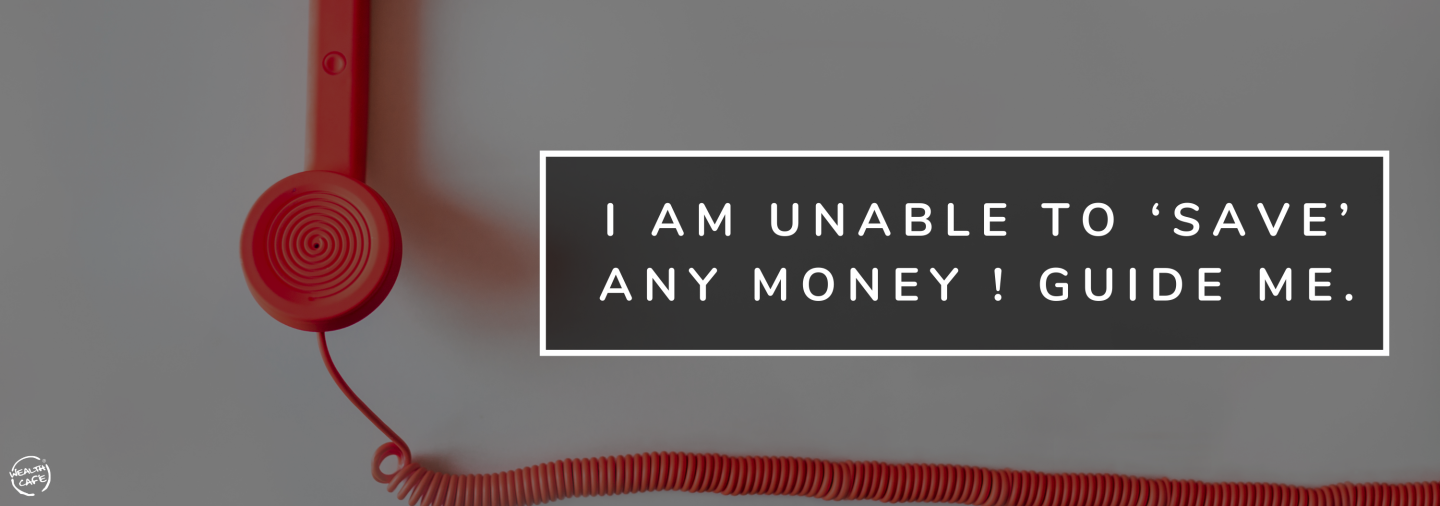A common question people ask is, "Where does all my money go?" Though they mean it as a joke, it's said with a sense of sadness. But the reason they don't know where their money goes isn't that they lost it or forgot the pin number to their bank card. They don't know where their money is going because they don't control the cash flow pattern of their money, their money controls them.
Once a young man named Raj approached us for our advice, as he was facing the same issue - how should he manage his expenses?. Raj is a bachelor living in Pune alone in a rented house away from his hometown, Lucknow. It's his first job so he wanted to enjoy his money but he is also responsible to send some back to his parents however, he just cannot save. Every month he feels, this is it, I am going to save money today but it just never happens. He approached us as he had no surplus of money left at the end of the month and hardly had any savings.
Are you A RAJ !!?
Does this happen to you? Do you feel you are doing everything right but you are still not saving any money at the end of the month? Let us help you with it.
Let's review Raj’s monthly income and expenses and help him find some money to save!
We believe everyone can save a bit if they just push themselves a bit.
Step 1 -Review of his monthly income & expenses - HIS CASH FLOWS
Raj’s Expenses:
| Particulars | Amounts |
| Rent | 15,000 |
| Toiletries + Basic monthly expenses | 5,000 |
| Bills | 5,000 |
| Sending to his family | 10,000 |
| Food | 18,000 |
| Traveling | 6,750 |
| Misc | 2,500 |
| TOTAL | 62,250 |
Raj’s Income = INR 60,000
Extra Spend/Loss = INR 2,250
Looking at his expenses it was a little difficult to figure out until we had a close look at it. Most of the expenses like Rent, Toiletries + Basic monthly expenses like utility bills & the amount that he uses to send his family were expenses that we couldn't fidget with and were his absolute needs. Further, we noticed that he was spending INR18,000 on food! So we asked him to share more details of the same. Traveling expenses and Miscellaneous expenses were also much more than one would expect someone to spend in Pune on a monthly basis. Therefore, we further explained to him how such expenses were harming his savings.
On a closer look at his expenses, we guided him to look at cheaper alternative options for things he was splurging (provided he was ready to make the shift). We also guide him on how these reduced expenses would increase his savings and when these savings are invested it would grow to be a substantial amount for him.
Wealth Cafe Solution:
Food:
So Raj was ordering in every meal (almost) and while it seemed fun and easy, it was making a huge hole in his pocket. So, rather than ordering we advised him to opt for having help to cook at home. Making food at home isn’t free, but it could probably squeeze out savings if,
- you buy your groceries in bulk
- if you are ready for home-cooked ‘good’ and ‘healthy food’
| Principal | No of meals
(per day) |
Cost per meal | Days | Total cost a month |
| When you order from outside | ||||
| How much do you spend | 2 | 300 | 30 | 18,000 |
| When you cook at home/or have help to do that | ||||
| Help expenses | 3,500 | |||
| Grocery spends | 5,000 | |||
| once a week you still order | 1 | 300 | 5 | 1,500 |
| 10,000 | ||||
| Monthly Savings | 8,000 |
Further, we explained to him how grocery shopping should be done, with the intention of saving money. The key here to save money is by buying groceries in bulk and managing it wisely. I have shown it in detail in the table below by taking an example of rice and wheat flour.
| Ration | Rice* | Flour* | Total |
| Where I order 1 kg | 180 | 55 | |
| how many times ordered | 5 | 5 | |
| The total cost of 5Kg | 900 | 275 | 1175 |
| Where I order 5 kg directly | 639 | 269 | 908 |
| Monthly Savings | 261 | 6 | 267 |
*Price referred from dmart website.
By buying Rice and Flour in bulk, one could save approx 23% in comparison to buying in small quantities. Raj could follow this with other grocery items as well so as to save his money.
By just shifting your monthly habit of ordering into cooking at home, he can have enough savings to start investments and SIPs. This may seem a very small thing but trust us many people get stuck to order in and this just changes everything in your monthly budget.
Traveling: (7 km)
| Principal | Cost per day (both side travel) | Days | Total cost a month |
| Uber/Auto/Taxi | 270 | 25 | 6,750 |
| Public transport (train + bus) | 50 | 25 | 1,250 |
| Monthly Savings | 5,500 |
By using an alternative, i.e, public transport Raj could save INR5,500 every month. That is INR 66,000 every year. Public transports are everywhere and paid for by our taxes. Which means it’s a bit of a waste if we don’t use them at all, right?
Miscellaneous
A major proportion of Raj’s miscellaneous expenses consisted of buying cigarettes. It is easy to look at small purchases and say “whatever, it’s only INR 15.” As standalone instances, INR 15 for anything isn’t a lot of money. However, spending INR 15, on a cigarette 5 times a day adds up to a lot of money per year.
In fact, it’s INR 27,000!
| Principal | No of cig | Days | Cost per cig | Total cost a month |
| How much do you spend | 5 | 30 | 15 | 2250 |
| Reduce it 1 a day | 1 | 30 | 15 | 450 |
| Monthly Savings | 1800 |
If Raj could decrease his cigarette intake from 5 times a day to once a day, it would save INR 1800 a month whereas INR 21,600 a year. I need not tell, as a bonus, it saves his doctor's expense as well in the coming future.
His expense now:
| Principal | Amounts
(Before) |
Amounts
(After) |
| Rent | 15,000 | 15,000 |
| Toiletries + Basic monthly expenses | 5,000 | 5,000 |
| Bills | 5,000 | 5,000 |
| sends family | 10,000 | 10,000 |
| Travelling | 6,750 | 1250 |
| Food order (does not cook) | 18,000 | 10,000 |
| Misc | 2,500 | 700 |
| TOTAL | 62,250 | 46,950 |
We do not deny the fact that savings are easy but it is not impossible. You can start with savings of INR 2000 each month or look at at least 10% of your monthly income and move forward. By cutting down his expense wisely Raj could save 15,300 (approx 25%) in comparison to before. He is saving INR 13000 monthly (INR 1,56,000 yearly) from his income, whereas he was spending more than his income with no surplus of money before.
Where we always talk about the approach of pay yourself first, where you transfer your fixed savings to a second bank account so even the urge of spending your money does not come in the way of your savings - NM 101: Maximise your Savings
So now that you know what you could be saving. Why not invest it?
As you see, he has a savings of 13,000 Rs, but by giving him INR 3000 for overheads, he could still invest INR 10,000. When making investment decisions, and investors’ portfolio distribution is influenced by factors such as personal goals, level of risk tolerance, and investment horizon. As Raj was towards balanced investment, his Debt-Equity Mix will be 50% debt and 50% equity. He invested INR 5000 in equity mutual funds which he could keep untouched for long-term goals whereas the other INR 5000 was diversified in liquid/short-term debt funds for emergency and short-term plans.
Did you see how easily the portfolio was diversified? You can learn more about diversification and how to invest in our course - NM 105: Plan & achieve your goals. Once he had a proper hang of investing and could increase his risk tolerance, he could diversify his investments even more after doing proper research. But remember, diversification of assets should be up to a limit. Over diversifying can hurt your investment returns.
LET’S GIVE HIM AN ADDITIONAL INCENTIVE TO SAVE! LET’S GIVE ONE TO YOU TOO !!
Spoiler: something beautiful happens. He builds more wealth!
Let’s assume Raj makes a 11.50 % average return on investing INR 10,000 (expected equity return =15%, Expected debt return = 8% and based on his ‘balanced’ risk profile)
Five years from now… he would have ₹8,05,849
Ten years from now… he would have ₹22,34,032
And in Twenty years… he would have ₹92,51,011
Don’t wait. Don’t hesitate. Don’t ponder and contemplate. Get started. Chances are good that at least some of the suggestions on this list will work for you and help you spend less money. By reducing your outflow and directing more money to financial goals, you'll be more successful in saving for big things so you can grow your net worth and build real wealth over time. It's worth the effort.
To learn more about Saving & Investments enroll in our course NM 101: Maximize your savings



